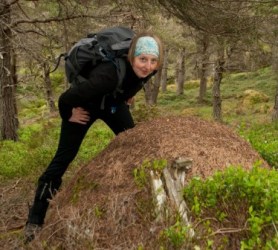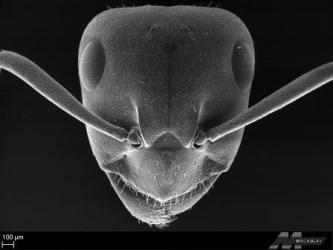Hello there! I’m Hayley and I’m the Caledonian Pinewood Invertebrates apprentice. I’m going to be based with the pinewood research team at the Macaulay Land Use Research Institute (soon to be the James Hutton Institute) in Aberdeen. As well as visiting pine forests in Aberdeenshire I also have placements at Abernethy forest and Mar Lodge near Braemar to check out Caledonian forests in the Cairngorms National Park.
A large part of my apprenticeship will involve studying the charismatic wood ants and to try and gain a better understanding of how these ants interact with the pinewoods and the other invertebrates that live there. With the help from data from Macaulay, I’m trying to piece together a food web for the invertebrates that live on Scots pine, no easy feat but should be useful way of understanding what all these beasties get up to. I’m also assisting the National Wood Ant Steering Group (a group of experts devoted to wood ant conservation) with a big public launch this summer and a symposium later in the year to help raise awareness of wood ants. Just to give you an idea of the impressive size that some ant nests can grow to (and this is small compared to some!), here’s a pic of me with a wood ant nest while carrying out fieldwork for my MSc last summer in the Cairngorms. I hope to see lots and lots more ant nests over the next 12 months! 
I’ll be especially on the look out for our rarest wood ant, Formica exsecta, to see what the current status of this ant is in Scotland and how sensitive woodland management can help conserve this species. At the moment I’m trying to gather together records for this beastie across Scotland so that a map can be plotted onto GIS. Hopefully this will help us to see if the range of this species has changed much over time and if the population is growing or declining.
As an interesting side project, I’ve been working alongside Evelyn Delbos who works with the Scanning Electron Microscope at Macaulay to try and get some mug shots of wood ants. We hope they could help highlight the identification features for the different species, most of which are found on their heads. The first lot of pictures for the Scottish wood ant (Formica aquilonia) have turned out great (see below), so hopefully images of the other wood ant species will follow as I collect specimens in the field. 
As well as scrambling around looking for ant hills, I hope to spend some time gaining a better understanding for the other invertebrate beasties that live in pinewoods, and there’s lots of pinewood specialists out there – hoverflies, solitary bees, spiders, and beetles to name a few and all special in their own way.
Spring is just around the corner and those sleepy little wood ants will be starting to wake up from hibernation soon….so for more from the pinewood patch watch this space!
Hayley Wiswell
Caledonian Pinewood Invertebrates Apprentice
